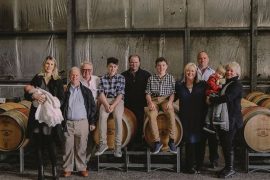
Review: Famous Detective Stories. True Tales of Australian Crime. NLA Publishing 2016, $24.99
In 2015 the State Library of NSW held an exhibition titled Pulp Confidential: Quick and Dirty Publishing from the 40s and 50s. This was put together from a collection the Library had purchased in the early 1960s from the family of the late Frank C. Johnson, owner of Frank Johnson Publishing. The collection, purchased for what could be described as a pulp fiction price of 250 pounds, lay dormant in the Library’s archives for many years, but was a goldmine of material from an era of Australian publishing that remains unique in our history.
Frank Johnson originally worked at Dymocks bookstores in Sydney but was closely associated with Sydney’s Bohemia and, together with Kenneth Slessor and Jack Lindsay, published an arts and literary magazine in the 1930s called Vision. The magazine didn’t last long but Johnson went on to publish Slessor’s Darlinghurst Nights and Eight Bells, among other works of respectability and literary merit. So why, you may ask, did he become the king of pulp fiction in Australia?
Penny Dreadfuls
Well, what happened was World War 2 and a publishing opportunity that Frank Johnson seized upon with flair and a keen understanding of the market. Before the war, pocket-sized paperbacks from America were widely popular in Australia, along with a gigantic range of comics. These “penny dreadfuls” covered a range of subjects offering an escape from the tedium of the Depression, including crime, the wild west and war stories. With newspaper kiosks on every railway station, they were cheap and easily accessible. My father always had one in his back pocket to read on the train – I knew who Zane Grey was before I knew who the Prime Minister was.
In 1940, in response to a shortage of US dollars, the Australian Government brought in a series of trade regulations that included a ban on American comic material. Frank Johnson was quick to seize the opportunity and moved to fill the gap with his publication of Amazing Comics. Not even a ban on new periodical publications stopped Frank. He simply changed the names of the booklets every week and went from strength to strength. The American publications had eliminated any references to Australia and Australian names, even when they had Australian authors, but Frank Johnson Publishing was proudly Australian and featured Australian content and characters, even producing a series on Australian racing.
His writers included moonlighting journalists and freelancers as well as keen amateurs. His artists and illustrators included names like Unk White and Emile Mercier. The most popular and longest running of Frank Johnson’s publications was Famous Detective Stories, published from 1946 to 1954. Each monthly issue featured a number of actual Australian crimes, usually, but not always, murder, and often with a provocative cover.
The story goes that the idea for Famous Detective Stories came out of a meeting between journalist Charlie Thompson and Frank Johnson over a few beers in Ushers Hotel in Castlereagh Street, Sydney. Thompson was a journalist with the Newcastle Sun and had access to all the newspaper files and clippings as well as a former CIB detective named Alfred Burvett, who had worked on a lot of famous crimes in the early part of the 20th century. Some of the most famous murders in Australian history were featured, including the Milperra Murder, the Mount Rennie Outrage and the Pyjama Girl Mystery, along with the exploits of the razor gangs in the 1920s.
The NLA publication reviewed here features a very good cross-section of stories from the Famous Detective Stories series covering crimes from every stage of Australia’s history, going back to colonial times and taking us up to the 1950s. There are amazing tales of large scale cattle duffing, blackbirding, serial husband poisoning and shoot outs with police on the streets of North Sydney. The good thing is that for most of us these are not crimes within our living memories, so they are all new and fascinating. Every story is accompanied by a range of actual and often sensational newspaper clippings from the time, giving a unique glimpse of how these crimes captured the headlines.
What I also found interesting was the different writing styles of the authors and the different way in which they unfolded these stories. If I have any criticism of this book it is that the publisher or editor didn’t include more information and background about Frank Johnson Publishing and the era of pulp fiction fascination in Australia. Fifteen lines is simply not enough to set the scene for a remarkable period in Australian publishing that, among other things, was the start of the true crime genre that still lives on with various publications and television shows such as Underbelly.
Call it Australian Noir, call it Pulp Confidential or just call it Frank Johnson Publishing, this is a significant period of Australian popular culture and deserves the recognition that this book gives it. If you relish crime and detective stories, this is a must for your collection.
Famous Detective Stories is available from the National Library of Australia online bookshop.




